+ Open data
Open data
- Basic information
Basic information
| Entry | Database: PDB / ID: 7d3s | ||||||
|---|---|---|---|---|---|---|---|
| Title | Human SECR in complex with an engineered Gs heterotrimer | ||||||
 Components Components |
| ||||||
 Keywords Keywords | MEMBRANE PROTEIN / CLASS B GPCR / Secretin / SECR / SIGNALING PROTEIN-HORMONE COMPLEX | ||||||
| Function / homology |  Function and homology information Function and homology informationsecretin receptor activity / digestive hormone activity / positive regulation of somatostatin secretion / negative regulation of gastrin-induced gastric acid secretion / positive regulation of pancreatic juice secretion / regulation of appetite / pancreatic juice secretion / positive regulation of lipid catabolic process / intracellular water homeostasis / embryonic digestive tract development ...secretin receptor activity / digestive hormone activity / positive regulation of somatostatin secretion / negative regulation of gastrin-induced gastric acid secretion / positive regulation of pancreatic juice secretion / regulation of appetite / pancreatic juice secretion / positive regulation of lipid catabolic process / intracellular water homeostasis / embryonic digestive tract development / G-protein activation / Activation of the phototransduction cascade / Glucagon-type ligand receptors / Thromboxane signalling through TP receptor / Sensory perception of sweet, bitter, and umami (glutamate) taste / G beta:gamma signalling through PI3Kgamma / G beta:gamma signalling through CDC42 / Cooperation of PDCL (PhLP1) and TRiC/CCT in G-protein beta folding / Activation of G protein gated Potassium channels / Inhibition of voltage gated Ca2+ channels via Gbeta/gamma subunits / Ca2+ pathway / G alpha (z) signalling events / High laminar flow shear stress activates signaling by PIEZO1 and PECAM1:CDH5:KDR in endothelial cells / Glucagon-like Peptide-1 (GLP1) regulates insulin secretion / G protein-coupled peptide receptor activity / Vasopressin regulates renal water homeostasis via Aquaporins / Adrenaline,noradrenaline inhibits insulin secretion / ADP signalling through P2Y purinoceptor 12 / G alpha (q) signalling events / G alpha (i) signalling events / Thrombin signalling through proteinase activated receptors (PARs) / Activation of G protein gated Potassium channels / G-protein activation / G beta:gamma signalling through PI3Kgamma / Prostacyclin signalling through prostacyclin receptor / G beta:gamma signalling through PLC beta / ADP signalling through P2Y purinoceptor 1 / Thromboxane signalling through TP receptor / Presynaptic function of Kainate receptors / G beta:gamma signalling through CDC42 / Inhibition of voltage gated Ca2+ channels via Gbeta/gamma subunits / G alpha (12/13) signalling events / Glucagon-type ligand receptors / G beta:gamma signalling through BTK / ADP signalling through P2Y purinoceptor 12 / Adrenaline,noradrenaline inhibits insulin secretion / Cooperation of PDCL (PhLP1) and TRiC/CCT in G-protein beta folding / Ca2+ pathway / Thrombin signalling through proteinase activated receptors (PARs) / G alpha (z) signalling events / Extra-nuclear estrogen signaling / photoreceptor outer segment membrane / G alpha (s) signalling events / G alpha (q) signalling events / spectrin binding / G alpha (i) signalling events / Glucagon-like Peptide-1 (GLP1) regulates insulin secretion / diet induced thermogenesis / High laminar flow shear stress activates signaling by PIEZO1 and PECAM1:CDH5:KDR in endothelial cells / Vasopressin regulates renal water homeostasis via Aquaporins / alkylglycerophosphoethanolamine phosphodiesterase activity / positive regulation of cAMP/PKA signal transduction / peptide hormone binding / PKA activation in glucagon signalling / developmental growth / hair follicle placode formation / photoreceptor outer segment / D1 dopamine receptor binding / intracellular transport / vascular endothelial cell response to laminar fluid shear stress / renal water homeostasis / activation of adenylate cyclase activity / Hedgehog 'off' state / cytoplasmic microtubule / adenylate cyclase-activating adrenergic receptor signaling pathway / cardiac muscle cell apoptotic process / photoreceptor inner segment / regulation of insulin secretion / cellular response to glucagon stimulus / adenylate cyclase activator activity / trans-Golgi network membrane / hippocampus development / response to nutrient levels / negative regulation of inflammatory response to antigenic stimulus / G protein-coupled receptor binding / hormone activity / brain development / bone development / regulation of synaptic plasticity / platelet aggregation / adenylate cyclase-modulating G protein-coupled receptor signaling pathway / cognition / G-protein beta/gamma-subunit complex binding / adenylate cyclase-activating G protein-coupled receptor signaling pathway / Prostacyclin signalling through prostacyclin receptor / Glucagon signaling in metabolic regulation / Glucagon-type ligand receptors / Vasopressin regulates renal water homeostasis via Aquaporins / sensory perception of smell / Glucagon-like Peptide-1 (GLP1) regulates insulin secretion Similarity search - Function | ||||||
| Biological species |  Homo sapiens (human) Homo sapiens (human)  unidentified (others) | ||||||
| Method | ELECTRON MICROSCOPY / single particle reconstruction / cryo EM / Resolution: 2.9 Å | ||||||
 Authors Authors | Fukuhara, S. / Kobayashi, K. / Kusakizako, T. / Shihoya, W. / Nureki, O. | ||||||
 Citation Citation |  Journal: Biochem Biophys Res Commun / Year: 2020 Journal: Biochem Biophys Res Commun / Year: 2020Title: Structure of the human secretin receptor coupled to an engineered heterotrimeric G protein. Authors: Satoshi Fukuhara / Kazuhiro Kobayashi / Tsukasa Kusakizako / Wataru Iida / Masahiko Kato / Wataru Shihoya / Osamu Nureki /  Abstract: Secretin is a gastrointestinal hormone that exerts multiple physiological functions via activation of the secretin receptor (SECR). SECR belongs to the class B G-protein-coupled receptors and is ...Secretin is a gastrointestinal hormone that exerts multiple physiological functions via activation of the secretin receptor (SECR). SECR belongs to the class B G-protein-coupled receptors and is involved in various processes, such as regulation of the pH of the duodenal content, food intake, and water homeostasis. Here, we report a cryo-electron microscopy structure of human SECR bound to secretin and an engineered Gs heterotrimer. The structure revealed the basic architecture of SECR and the secretin binding mode. A structural comparison of the SECR and PAC1R transmembrane domains revealed that transmembrane helices 1 and 2 play a prominent role in secretin recognition. Moreover, the extracellular domain of SECR is perpendicular to the TMD, unlike that of PAC1R. This comparison revealed the diverged peptide recognition mechanisms of these receptors, which belong to the same subgroup. Our structural information will facilitate drug discovery research for clinical applications. | ||||||
| History |
|
- Structure visualization
Structure visualization
| Movie |
 Movie viewer Movie viewer |
|---|---|
| Structure viewer | Molecule:  Molmil Molmil Jmol/JSmol Jmol/JSmol |
- Downloads & links
Downloads & links
- Download
Download
| PDBx/mmCIF format |  7d3s.cif.gz 7d3s.cif.gz | 204.5 KB | Display |  PDBx/mmCIF format PDBx/mmCIF format |
|---|---|---|---|---|
| PDB format |  pdb7d3s.ent.gz pdb7d3s.ent.gz | 155.2 KB | Display |  PDB format PDB format |
| PDBx/mmJSON format |  7d3s.json.gz 7d3s.json.gz | Tree view |  PDBx/mmJSON format PDBx/mmJSON format | |
| Others |  Other downloads Other downloads |
-Validation report
| Summary document |  7d3s_validation.pdf.gz 7d3s_validation.pdf.gz | 1.1 MB | Display |  wwPDB validaton report wwPDB validaton report |
|---|---|---|---|---|
| Full document |  7d3s_full_validation.pdf.gz 7d3s_full_validation.pdf.gz | 1.1 MB | Display | |
| Data in XML |  7d3s_validation.xml.gz 7d3s_validation.xml.gz | 40.4 KB | Display | |
| Data in CIF |  7d3s_validation.cif.gz 7d3s_validation.cif.gz | 61.5 KB | Display | |
| Arichive directory |  https://data.pdbj.org/pub/pdb/validation_reports/d3/7d3s https://data.pdbj.org/pub/pdb/validation_reports/d3/7d3s ftp://data.pdbj.org/pub/pdb/validation_reports/d3/7d3s ftp://data.pdbj.org/pub/pdb/validation_reports/d3/7d3s | HTTPS FTP |
-Related structure data
| Related structure data |  30566MC M: map data used to model this data C: citing same article ( |
|---|---|
| Similar structure data |
- Links
Links
- Assembly
Assembly
| Deposited unit | 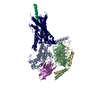
|
|---|---|
| 1 |
|
- Components
Components
-Guanine nucleotide-binding protein ... , 3 types, 3 molecules ABG
| #3: Protein | Mass: 44255.664 Da / Num. of mol.: 1 Mutation: deletion 254-263, G49D,E50N,L63Y,A249D,S252D,I375A,V375I Source method: isolated from a genetically manipulated source Source: (gene. exp.)  Homo sapiens (human) / Gene: GNAS, GNAS1, GSP / Production host: Homo sapiens (human) / Gene: GNAS, GNAS1, GSP / Production host:  |
|---|---|
| #4: Protein | Mass: 38744.371 Da / Num. of mol.: 1 Source method: isolated from a genetically manipulated source Source: (gene. exp.)   |
| #5: Protein | Mass: 7547.685 Da / Num. of mol.: 1 Source method: isolated from a genetically manipulated source Source: (gene. exp.)   |
-Protein/peptide / Protein / Antibody , 3 types, 3 molecules PRN
| #1: Protein/peptide | Mass: 3045.436 Da / Num. of mol.: 1 / Source method: obtained synthetically / Source: (synth.)  Homo sapiens (human) / References: UniProt: P09683 Homo sapiens (human) / References: UniProt: P09683 |
|---|---|
| #2: Protein | Mass: 49742.422 Da / Num. of mol.: 1 Source method: isolated from a genetically manipulated source Source: (gene. exp.)  Homo sapiens (human) / Gene: SCTR / Production host: Homo sapiens (human) / Gene: SCTR / Production host:  |
| #6: Antibody | Mass: 15015.728 Da / Num. of mol.: 1 Source method: isolated from a genetically manipulated source Source: (gene. exp.) unidentified (others) / Production host:  |
-Details
| Has protein modification | Y |
|---|
-Experimental details
-Experiment
| Experiment | Method: ELECTRON MICROSCOPY |
|---|---|
| EM experiment | Aggregation state: PARTICLE / 3D reconstruction method: single particle reconstruction |
- Sample preparation
Sample preparation
| Component |
| ||||||||||||||||||||||||||||||||||||||||||||||||
|---|---|---|---|---|---|---|---|---|---|---|---|---|---|---|---|---|---|---|---|---|---|---|---|---|---|---|---|---|---|---|---|---|---|---|---|---|---|---|---|---|---|---|---|---|---|---|---|---|---|
| Molecular weight | Experimental value: NO | ||||||||||||||||||||||||||||||||||||||||||||||||
| Source (natural) | Organism:  Homo sapiens (human) Homo sapiens (human) | ||||||||||||||||||||||||||||||||||||||||||||||||
| Source (recombinant) |
| ||||||||||||||||||||||||||||||||||||||||||||||||
| Buffer solution | pH: 8 | ||||||||||||||||||||||||||||||||||||||||||||||||
| Specimen | Conc.: 5.4 mg/ml / Embedding applied: NO / Shadowing applied: NO / Staining applied: NO / Vitrification applied: YES | ||||||||||||||||||||||||||||||||||||||||||||||||
| Vitrification | Instrument: FEI VITROBOT MARK IV / Cryogen name: ETHANE / Humidity: 100 % / Chamber temperature: 277 K |
- Electron microscopy imaging
Electron microscopy imaging
| Experimental equipment |  Model: Titan Krios / Image courtesy: FEI Company |
|---|---|
| Microscopy | Model: FEI TITAN KRIOS |
| Electron gun | Electron source:  FIELD EMISSION GUN / Accelerating voltage: 300 kV / Illumination mode: OTHER FIELD EMISSION GUN / Accelerating voltage: 300 kV / Illumination mode: OTHER |
| Electron lens | Mode: BRIGHT FIELD |
| Image recording | Electron dose: 50.8 e/Å2 / Film or detector model: GATAN K3 (6k x 4k) / Num. of real images: 2142 |
- Processing
Processing
| EM software | Name: PHENIX / Version: 1.14 / Category: model refinement / Details: phenix.real_space_refine |
|---|---|
| CTF correction | Type: PHASE FLIPPING AND AMPLITUDE CORRECTION |
| 3D reconstruction | Resolution: 2.9 Å / Resolution method: FSC 0.143 CUT-OFF / Num. of particles: 617465 / Symmetry type: POINT |
| Atomic model building | Protocol: OTHER |
| Atomic model building | PDB-ID: 5VAI Accession code: 5VAI / Source name: PDB / Type: experimental model |
 Movie
Movie Controller
Controller




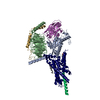



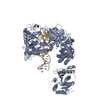


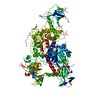
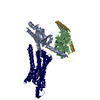
 PDBj
PDBj

















